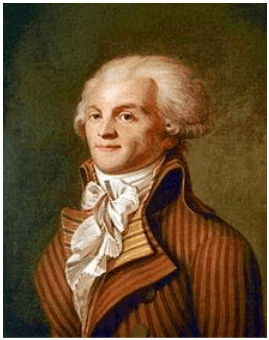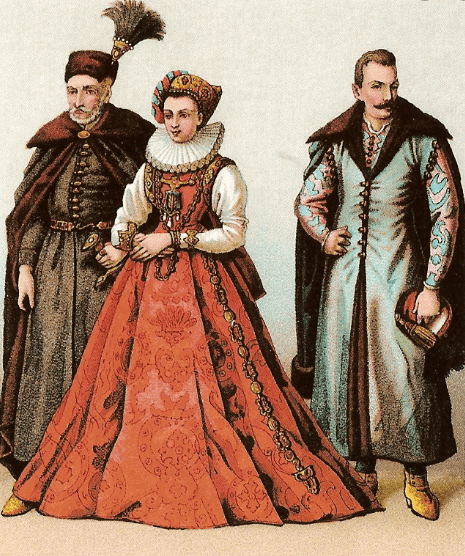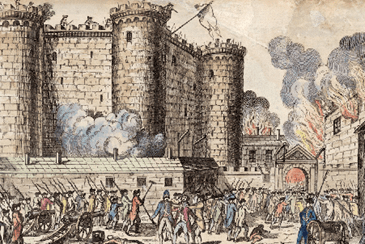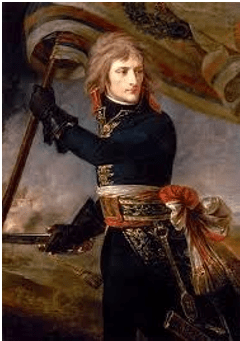Class 9 History Chapter 1 Question Answers - The French Revolution
Q.26. Describe any three causes for the fall of the Jacobin government in France.
Ans. The causes for all of the Jacobin government were:
(i) Many persons who were seen as 'enemies' of the republic, i.e., those who did not agree with the strict measures taken by Robespierre, were executed.
(ii) A maximum ceiling was fixed on wages and prices. Rationing of essential food items was introduced, causing hardships to the people.
(iii) Churches were shut down and converted into barracks or offices, causing resentment in the clergy.
 Maximilien RobespierreQ.27. Describe the divisions in French society before the French Revolution.
Maximilien RobespierreQ.27. Describe the divisions in French society before the French Revolution.
Or
Describe the French division of society.
Ans. The French society was divided into three estates:
(i) First Estate comprised of the Church and the clergy. They enjoyed certain privileges by birth. They were exempted from paying taxes to the state.
(ii) Second Estate: They were big aristocrats and landlords. They were considered above the law and exempted from paying taxes.
(iii) Third Estate: This comprised the peasants, artisans, city workers and the middle class people like teachers, doctors, lawyers, writers, etc. All such people had no political rights. They had to pay many kinds of taxes.
Q.28. How did peasants protest against the feudal lords or nobles of France?
Ans. (i) In the countryside, there were rumors that the landlords of the manor had hired criminals to destroy the ripe crops of the peasants.
(ii) Being afraid of the situation, peasants in several districts seized hoes and pitchforks and attacked chateaux (castles belonging to the noblemen). They looted the hoarded grain.
(iii) They also burnt down documents containing records of the manorial dues. As a result, a larger number of nobles fled from their hometowns and migrated to neighboring countries. Nobles in FranceQ.29. How did France become a Constitutional monarchy?
Nobles in FranceQ.29. How did France become a Constitutional monarchy?
Ans. In 1791, the National Assembly completed the draft of the Constitution. Its main object was to limit the powers of the monarch. The powers, instead of being concentrated in the hands of the monarch, were now separated and divided between the Legislature, the Executive, and the Judiciary. The Constitution also declared that it was the duty of the state to protect each citizen's natural rights. In this way, France became a Constitutional monarchy.
Q.30. Differentiate between active and passive citizens of France.
Ans. In France, only men above 25 years of age who paid taxes equal to at least 3 days of a laborer's wage were given the status of active citizens. They were entitled to vote. The remaining men, as well as women who were not entitled to vote, were called passive citizens. At that time, to qualify as an elector and a member of the assembly, a man had to belong to the highest bracket of taxpayers.
Q.31. What was the condition of women in France before the revolution? Or Evaluate the role of women in France before the revolution.
Ans.
(i) The role of women in France before the revolution was that all women were classed as passive citizens. They did not have voting powers.
(ii) They worked as seamstresses or laundresses, sold flowers, fruits, and vegetables, or worked as domestic servants.
(iii) Their wages were lower than those of men.
(iv) They looked after their children, cooked, fetched water, and queued for bread.
(v) Most women did not have access to education or job training. Only daughters of wealthy parents could study at a convent, after which they were married off.
Q.32. Which laws were made to improve the status of women in French society?
Or
Discuss any four steps taken by the revolutionary government of France to improve the lives of women.
Or
State any five laws introduced by the revolutionary government in France that helped to improve the lives of women.
Ans. In the beginning, the revolutionary government introduced some laws to improve the status of women in society. These were
(i) Schooling was made compulsory for all girls.
(ii) Their fathers could no longer force them into marriage against their will. If they did so, they were punished.
(iii) Marriage was made into a contract entered into freely, and it was registered under civil law.
(iv) Divorce was made legal and could be applied for by both men and women.
(v) Women could train for jobs, become artists, or run small businesses.
Q.33. What was the guillotine? How was it used?
Ans. The guillotine was a device consisting of two poles and a blade with which a person was beheaded. It was used by Robespierre, who followed a policy of 'Reign of Terror', i.e., of severe control and punishment. Those who did not agree with his methods were arrested, imprisoned, and then tried by a revolutionary tribunal. If the court found them 'guilty', they were guillotined.
Q.34. Compare the manifesto drafted by Olympe de Gouges with the Declaration of the Rights of Man and Citizen.
Or
Name one of the most important of the politically active women in revolutionary France. What do you know about her?
Ans. While the manifesto drafted by Olympe de Gouges talked primarily about women and equality, the Declaration of Rights of Man and Citizen talked only about men. The manifesto sought to give political, social, and economic equality to all citizens, including men and women. On the other hand, the Declaration of the Rights of Man and Citizen denied privileges to women. They were sidelined as passive citizens.
 Olympe de Gouges
Olympe de Gouges
Q.35. Explain any five features of the Constitution of 1791, framed by the National Assembly in France.
Or
Write three main features of the French Constitution of 1791.
Ans. The National Assembly completed the draft of the Constitution in 1791.
(i) It declared France as a Constitutional monarchy.
(ii) The powers of the king were separated and assigned to different institutions - the Legislature, the Executive, and the Judiciary.
(iii) The National Assembly was given the power to make laws.
(iv) To qualify as an elector or member of the assembly, a man had to belong to the highest bracket of taxpayers.
(v) Only men above 25 years of age who paid taxes equal to at least 3 days of a laborer's wage were given the status of the active citizen, i.e., voters.
Q.36. The 18th century France witnessed the emergence of the middle class. Who were they, and what were their ideas?
Ans. In the 18th century, the middle class was a social group that earned their wealth through expanding overseas trade and from the manufacture of goods such as woolen and silk textiles. In addition to merchants and manufacturers, it also included lawyers and administrative officials.
They were well educated and believed that:
(i) No group in society should be privileged by birth.
(ii) A person's social position must depend on his merit.
(iii) A society must be based on freedom and equal laws and opportunities for all.
(iv) Locke, Rousseau, and Montesquieu maintained this idea.
Q.37. What was the important law that came into effect soon after the storming of the Bastille in the summer of 1789? How did it change the lives of the common people? Explain.
Ans. After the fall of the Bastille in the summer of 1789, one important law that came into effect was the abolition of censorship. Before the French Revolution, all written material and cultural activities? books, newspapers, and plays could be published or performed only after they had been approved by the censors of the king.
This law changed the lives of the common people in the following ways:
(i) The Declaration of the Rights of Man and Citizen proclaimed freedom of speech and expression to be a natural right.
(ii) Newspapers, pamphlets, books and printed pictures flooded the towns of France from where they could rapidly reach the countryside.
(iii) These all discussed events and changes that took place in France.
(iv) Freedom of the press meant that opposing views of events could be expressed.
(v) Plays, songs, and festive processions attracted common men through which they could identify the ideas of liberty or justice of the political philosophers.
 Storming of the BastilleQ.38. Explain the triangular slave trade carried on during the 18th and 19th centuries.
Storming of the BastilleQ.38. Explain the triangular slave trade carried on during the 18th and 19th centuries.
Ans.
The triangular slave trade flourished in the 18th century and 19th century as:
(i) There was a shortage of labour in the colonies in the Caribbean due to Europeans' reluctance to go and work in distant, unfamiliar places.
(ii) This problem was solved by a triangular slave trade between Europe, Africa and America. The slave trade began in the 17th century.
(iii) French merchants sailed from the ports of Bordeaux or Nantes to the African coast, where they bought slaves from local chieftains.
(iv) The slaves were brought to the Caribbean and were sold to plantation owners.
(v) The exploitation of slave labor made it possible to meet the growing demand in European markets for sugar, coffee, and indigo.
Q.39. Write a short note on Napoleon Bonaparte.
Ans.
In 1804, Napoleon Bonaparte crowned himself as the Emperor of France:
(i) In the administrative field, he incorporated many revolutionary principles which made the whole system more rational and efficient.
(ii) His Civil Code of 1804 (known as the Napoleonic code) did away with all privileges based on birth, established equality before the law, and secured the right to private property.
(iii) He introduced a uniform system of weights and measures provided by the decimal system.
(iv) Initially, many believed Napoleon was a liberator who would bring freedom to the people.
(v) Many of his reforms were exported to the regions under French control. These left a long-lasting effect on society.
 Napoleon Bonaparte
Napoleon Bonaparte
Q.40. What do you understand by the term 'Reign of Terror'?
Ans. The period from 1793 to 1794 is referred to as the 'Reign of Terror' because, during this time, Robespierre followed a policy of severe control and punishment. All those whom he regarded as being 'enemies' of the republic, e.g., nobles, clergy, or members of his or other political parties, were arrested and tried by a revolutionary tribunal. If found guilty, they were guillotined. More than 15000 persons were guillotined during this period. The 'Reign of Terror' became intolerable, and people were against Robespierre and his followers. Finally, Robespierre was convicted and guillotined in July 1794, and the Reign of Terror ended with his death.
Q.41. (i) Which groups of French society benefited from the revolution?
(ii) Which groups were forced to relinquish power?
(iii) Which sections of society would have been disappointed with the outcome of the revolution?
Ans.
(i) All the groups that formed the third estate benefited from the revolution. These groups included workers, businessmen, merchants, court officials, lawyers, teachers, and doctors, etc.
(ii) The classes that formed the privileged sections of society, like the nobility, clergy, and aristocracy, were forced to relinquish their executive powers.
(iii) Naturally, the privileged classes, viz, the clergy and the nobles, would have been disappointed with the outcome of the revolution because their privileges were taken away from them.
Q.42. Draw up a list of democratic rights we enjoy today whose origins could be traced to the French Revolution.
Or
Mention any five values that are associated with the Declaration of the Rights of Man and Citizen.
Ans. Some of the democratic rights that we enjoy today, whose origins could be traced to the French Revolution, are given in the Indian Constitution.
(i) Right to Equality: The right to equality originated during the French Revolution. In the Indian Constitution, the right to equality means equality before the law, prohibition of discrimination, and equality of opportunity in matters of employment.
(ii) Right to Liberty or Freedom: The origin of this right can also be traced to the French. In the Preamble to the Indian Constitution, the Right to Liberty or freedom means 'freedom of thought, expression, belief, faith and worship.'
(iii) Encouraging the Spirit of Fraternity: The French Revolution introduced the growth of the spirit of fraternity and social welfare. In the Indian Constitution the concept of 'fraternity' abolishes untouchability, local or provincial anti-social feelings.
(iv) Inspiring the Spirit of Democracy: The French Revolution inspired the spirit of democracy, which ensured many rights, viz., the right against exploitation, the right to life, the right to vote, etc, which we are enjoying today.
(v) Liberty: It consists of the power to do whatever is not hampering the interests of others. The Constitution declared that these rights belonged to each human.
Q.43. What is the role of philosophers in the French Revolution?
Ans.
The revolutionary ideas of philosophers encouraged people to fight for their rights:
(i) Voltaire believed that man's destiny was in his own hands.
(ii) John Locke criticized the divine and absolute rights of rulers.
(iii) Rousseau put forward the idea of the formation of a government based on a social contract between people and their representatives. Men had the right to change their government if they were not satisfied with it.
(iv) Montesquieu believed that all powers should not be concentrated in one person's hand. They should be divided between the Legislature, the Executive, and the Judiciary. The ideas of these philosophers were discussed by common people in salons and coffeehouses and inspired them to fight for their rights.
Q.44. How was slavery abolished in France?
Or
Explain the process of slavery abolition in France.
Ans. One of the most revolutionary social reforms of the Jacobin regime was the abolition of slavery. An acute shortage of labor in the French Caribbean colonies, Martinique, Guadeloupe, and San Domingo, led to a triangular slave trade between Europe, Africa, and America in the 17th century. The National Assembly held long debates, and finally. The Convention in 1794 passed laws freeing slaves in the French overseas possessions, but it lasted for a short time. After ten years, slavery was reintroduced by Napoleon. Finally, it was abolished in 1848.
Q.45. The French Revolution popularised many symbols. Each symbol depicted some basic values. Mention such symbols and related values.
Ans.
- The Broken Chain was used to fetter slaves. A broken chain symbolized freedom from slavery.
- The Bundle of Rods or Fasces: One rod can be easily broken, but not an entire bundle. It symbolizes strength lies in unity.
- The Eye within a Triangle Radiating Light: The all-seeing eye stands for knowledge. The rays of the Sun will drive away from the clouds of ignorance. It depicts knowledge and removes ignorance.
- Scepter: It was a symbol of royal power. It depicted the power of autocracy.
- Snake Biting its tail to form a Ring: This type of ring has neither beginning nor end. It is a symbol of eternity.
- Red Phrygian Cap: It was worn by a slave upon becoming free. It symbolizes freedom from bondage or slavery.
- Blue-White Red: These were the national colors of France. The use of these colors depicted nationalism.
Q.46. In 'The Spirit of the Laws', Montesquieu proposed a division of power within the government between the Legislative, the Executive and the Judiciary. Explain the values which can be reflected in this proposal.
Ans. The values which can be derived from Montesquieu's proposal are:
(i) Power Sharing Montesquieu suggested a division of power within the government between the Legislative, the Executive and the Judiciary. This arrangement refuted the absolute right of the king.
(ii) Equality There would be no special privileges for the first and second estates, i.e., the clergy and nobility. Everybody in the country should enjoy equal status.
(iii) Expansion of People's Power Montesquieu opposed the theory of the 'Divine Right of the King'. His concept of separation of powers is a prerequisite to eliminating corruption from the administration.
Q.47. What was the impact of the French Revolution on the world? Give your points.
Or
What was the impact of the French Revolution on the world? Name two Indians who were very much influenced by revolutionary France.
Or
Describe the legacy of the French Revolution for the people of the world.
Ans. Ideologically, the impact of the French Revolution on the world was immense:
(i) The ideas of liberty and democratic rights were the most important legacy of the French Revolution. These ideas spread from France to the rest of Europe during the 19th century, when feudal systems were abolished.
(ii) Colonised people in Africa, Asia, and Latin America reworked the idea of freedom from bondage into their movements to create a sovereign nation-state.
(iii) The French Revolution led to the end of monarchy in France. A society based on privileges gave way to a new system of governance.
(iv) The idea that all individuals had rights and could claim equality became part of the new language of politics, but in different countries, they were reinterpreted and rethought. Tipu Sultan and Raja Rammohan Roy are two Indians who were very much influenced by the revolution in France.
Q.48. What were the causes of the empty treasure of France under Louis XVI? Assess any three causes.
Or
State any five causes for the empty treasury of France under Louis XVI. (v) Lenders who had given the state credit now began to charge 10 percent interest on the existing loans. So, the French government had to spend an increasing percentage of its budget on interest payments.
Ans. In 1774, Louis XVI of the Bourbon family of kings ascended the throne of France. He found an empty treasury.
The causes for it were:
(i) Long years of wars had drained the financial resources of France. The condition was served when, under Louis XVI, France helped the thirteen American colonies gain their independence from Britain.
(ii) The king's court at the immense Palace of Versailles was extravagant. A huge amount of money was required for its maintenance.
(iii) Taxes were levied only on the third estate and exempted the first and second estates, which were rich.
(iv) The war with Britain added more than a billion livres to a debt that had already risen to more than 2 billion livres.
(v) Lenders who had given the state credit have now begun to change 10 percent of the interest on the existing loans. So, the French government had to spend an increasing percentage of its budget on interest payments.
Q.49. Why did the subsistence crisis frequently occur in France during the Old Regime?
Or
List any five reasons that led to the subsistence crisis in France during the Old Regime.
Ans. A subsistence crisis means an extreme situation where the basic means of livelihood are endangered. During the Old Regime, a subsistence crisis frequently occurred in France.
The reasons that led to the subsistence crisis are:
(i) The population of France rose from about 23 million in 1715 to 28 million in 1789, which led to a rapid increase in the demand for food grains.
(ii) Production of grains could not keep pace with the increasing demand. So, the price of the foodstuff, which is made from grains, rose rapidly.
(iii) Most workers were employed as laborers on fixed wages. Their wages could not keep pace with the rise in prices.
(iv) The gap between the poor and the rich widened. Poor remain poor, but the rich become richer.
(v) The crisis of food grains became worse whenever drought or hail reduced the harvest.
Q.50. What were the results of the French Revolution for France?
Or
What landmark decisions were taken by the National Assembly led by the third estate on the 4th of August, 1789?
Ans. In June 1789, the representatives of the third estate declared themselves a National Assembly. They drafted a constitution for France.
(i) They discarded the power of absolute monarchy. Even Louis XVI accepted the fact that his powers would be checked by a Constitution.
(ii) On 4th August 1789, the assembly passed a decree abolishing the feudal system of obligations and taxes.
(iii) Members of the clergy were forced to give up their privileges.
(iv) Tithe was abolished, and lands owned by the Church were also confiscated.
(v) As a direct consequence of these measures taken by the government, the government acquired assets worth at least 2 billion lives.
|
55 videos|525 docs|78 tests
|
FAQs on Class 9 History Chapter 1 Question Answers - The French Revolution
| 1. What were the main causes of the French Revolution? |  |
| 2. What was the significance of the Storming of the Bastille? |  |
| 3. How did the French Revolution impact the role of women in society? |  |
| 4. What were the main outcomes of the French Revolution? |  |
| 5. How did the French Revolution influence other countries? |  |






















